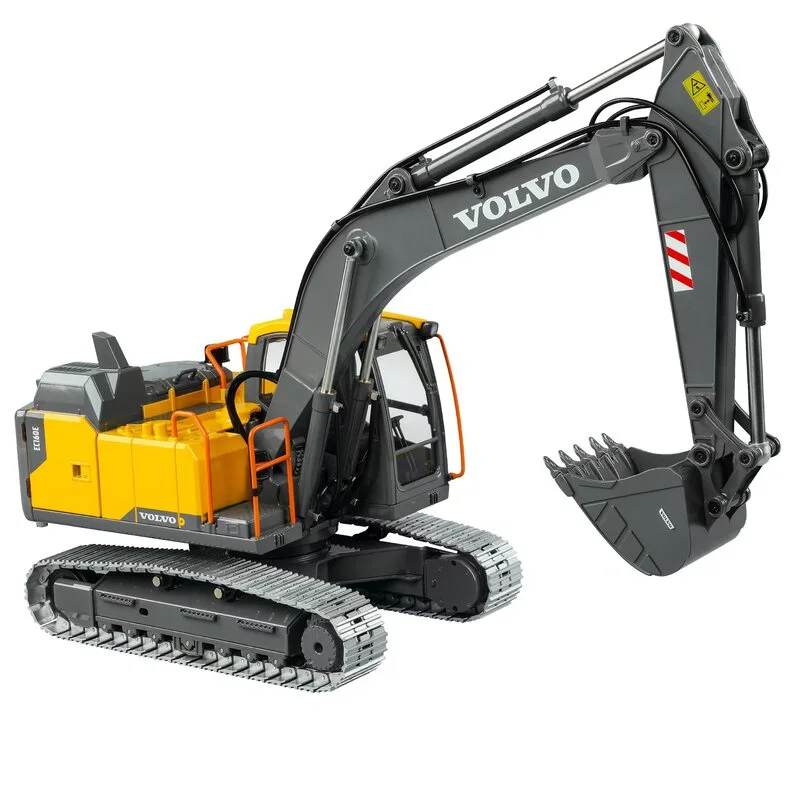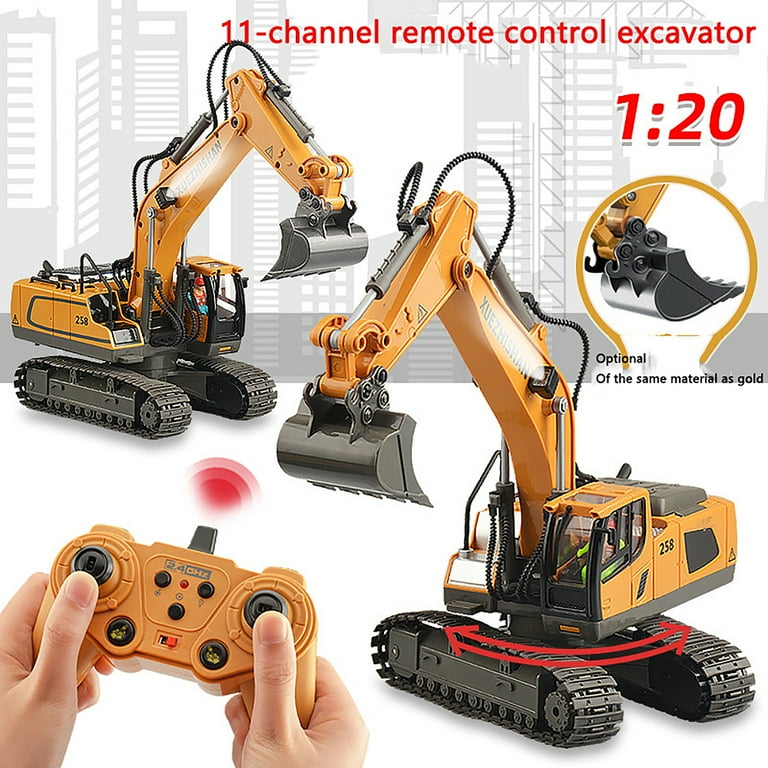The Essential Features of Excavator That Make Things a Must-Have Tool
Excavators are crucial in the building and landscaping industries. Their versatile add-ons permit a series of tasks, from excavating to demolition. In addition, they boast superior digging depth and reach, powered by robust engines. Driver comfort and small styles enhance use in numerous settings. What really establishes excavators apart are their sophisticated hydraulic systems and toughness. Recognizing these features can clear up why they are taken into consideration crucial devices on any type of work site.
Versatile Attachments for Boosted Performance
Excavators are powerful equipments on their own, the enhancement of functional attachments significantly improves their performance. These add-ons change a basic excavator right into a multi-purpose device, appropriate for a selection of jobs. Containers, as an example, come in various sizes and shapes, allowing operators to dig, scoop, and relocate materials effectively. Hydraulic thumbs can be added for boosted gripping and handling of bulky items, such as logs or rocks.Furthermore, specialized add-ons like breakers and augers allow for exploration and demolition work, broadening the excavator's energy on construction sites. remote control excavator. Grapples are an additional choice, suitable for relocating and arranging debris. This versatility not only raises performance yet additionally minimizes the need for numerous machines, conserving time and expenses. By furnishing excavators with the right add-ons, operators can deal with diverse jobs, making them vital in the construction industry
Superior Excavating Deepness and Get To
Excavators are designed with exceptional digging depth and reach, enabling them to maneuver in limited rooms and gain access to hard-to-reach areas. This capability is vital for numerous building and excavation tasks, where typical machinery might fail. With adjustable boom arms and extendable tracks, excavators can quickly browse uneven terrain while preserving stability.The excavating deepness can differ significantly amongst designs, often ranging from 10 to 25 feet, depending upon the design and objective. This feature allows drivers to dig deep into foundations, trenches, and other deep structures successfully. In addition, the reach of an excavator enables exact digging and material handling without rearranging the machine regularly, saving time and labor costs.Ultimately, the remarkable digging deepness and reach of excavators make them important for experts looking for to finish intricate tasks with precision and efficiency. Their adaptability boosts productivity on job sites, showcasing them as a vital device in modern-day construction.
Powerful Engine Performance

When it pertains to effectiveness and efficiency on building websites, powerful engine efficiency plays a pivotal duty in the capabilities of an excavator. A durable engine creates considerable horsepower, enabling the equipment to tackle heavy-duty jobs with simplicity - remote control excavator. This stamina converts into faster cycle times, enabling operators to full tasks a lot more quickly.Additionally, powerful engines provide the necessary torque to take care of challenging surfaces and varied loads, making certain that the excavator can execute successfully under different problems. Whether it is lifting, digging, or moving products, the engine's efficiency straight influences the overall operational efficiency of the machine.Furthermore, innovations in engine innovation have caused improved gas efficiency, reducing operational costs while keeping power outcome. Eventually, the engine's performance acts as the backbone of an excavator, attesting its status as an essential tool in the building and construction market
Advanced Hydraulic Equipments

Improved Raising Ability
A substantial improvement in lifting ability can be credited to advanced hydraulic systems discovered in modern-day excavators. These systems utilize high-pressure liquid to create greater pressure, allowing operators to lift heavier lots with simplicity. The engineering behind these hydraulics warranties peak efficiency, providing a remarkable power-to-weight ratio that improves total effectiveness. As an outcome, excavators can tackle demanding jobs, such as raising huge products or devices, without compromising security. Furthermore, the robust design of hydraulic parts contributes to increased toughness and dependability, making them appropriate for numerous building and construction environments. This boosted training ability not only lowers the moment required for tasks yet also minimizes the requirement for extra machinery, confirming crucial for both performance and cost-effectiveness in the building and construction sector.
Boosted Accuracy Control
Although traditional excavators usually had a hard time with precision, modern-day hydraulic systems have actually changed control systems, making it possible for operators to implement tasks with remarkable precision. These innovative systems make use of proportional control valves that permit smoother and extra responsive movements, substantially reducing the margin for mistake. Operators can now carefully tune the excavator's activities, making it less complicated to browse limited spaces and handle fragile products. Enhanced feedback systems further inform operators of real-time performance, making certain suitable sychronisation between the equipment and driver. This boosted accuracy not only enhances performance yet likewise improves safety on job websites, minimizing the danger of accidents. Because of this, informative post modern-day excavators geared up with advanced hydraulic systems are invaluable devices for building and excavation projects calling for precise precision.
Driver Convenience and Visibility
Driver convenience and visibility are critical parts in the style of modern-day excavators (remote control excavator). Attributes such as ergonomic seat style, enhanced visibility alternatives, and effective control designs considerably boost the operator's experience and productivity. Prioritizing these elements warranties that drivers can work successfully and securely in different problems
Ergonomic Seat Design
Convenience and presence are paramount in excavator layout, with the ergonomic seat playing a necessary duty in enhancing the driver's experience. An ergonomic seat is engineered to support the operator's body, minimizing tiredness during lengthy hours of procedure. Flexible functions, such as seat elevation, back-rest angle, and back assistance, cater to specific preferences and advertise optimal posture. These modifications boost comfort and make it possible for the operator to preserve concentrate on tasks without pain. Additionally, a properly designed seat can supply much better lateral support, enabling for smoother handling when the excavator is in procedure. This thoughtful design not only improves performance however likewise adds to overall security, guaranteeing that operators can do their obligations properly and effectively.
Improved Visibility Features
The design of an excavator extends past just the seat, with enhanced exposure functions playing a considerable function in operator convenience and total security. Large windows and strategically located mirrors offer drivers with a clear view of their surroundings, reducing dead spots. This design consideration permits better spatial recognition, which is necessary in busy job atmospheres. In addition, numerous excavators integrate rearview cameras and advanced tracking systems that aid drivers in navigating tight spaces. The integration of these presence features not just promotes security but additionally minimizes operator fatigue by allowing simpler monitoring of workspace. Eventually, boosted presence adds to a lot more efficient procedures and helps guarantee that excavators can execute their tasks effectively and safely.
Control Layout Performance
While handling complicated job websites, an effective control design considerably boosts both operator comfort and presence. A well-designed control arrangement guarantees that operators can access essential features with very little effort, minimizing exhaustion throughout lengthy hours. Ergonomic joystick placements and instinctive switch setups enable seamless procedure, making it possible for operators to maintain concentrate on the task available. Furthermore, clear exposure of both the workplace and the control board is important for safety and security and accuracy. Modern excavators frequently include flexible seating and control setups to suit different driver choices, further boosting convenience. Inevitably, a thoughtfully made control design not only improves performance but additionally fosters a safer working setting by allowing operators to respond quickly to altering conditions.
Compact Style for Urban Environments
As city building sites typically encounter area restraints, a small style becomes important for excavators running in these environments. These makers are crafted to browse limited rooms, permitting effective ability to move in crowded work websites. A decreased footprint allows them to function very closely to existing frameworks, decreasing interruption and making the most of productivity.The portable design commonly includes shorter tracks and a tighter transforming distance, promoting operation in narrow streets and constrained locations. Lightweight materials add to alleviate of transport, making it less complex to relocate the excavator from one place to another other within the metropolitan landscape.Additionally, numerous compact excavators are furnished with attributes such as flexible add-ons and extendable arms, improving their performance while keeping a little size. This adaptability permits operators to take on a variety of tasks, from excavating to demolition, all while suitable effortlessly right into the restraints of urban settings.

Resilience and Maintenance Considerations
Resilience stands as a necessary element in the efficiency and long life of excavators, especially sought after urban atmospheres. These devices go through strenuous problems, consisting of differing soil types, extreme temperature levels, and high-frequency usage. Premium products and durable construction are necessary for making certain that excavators can withstand these challenges without compromising functionality.Regular upkeep is similarly vital in maintaining sturdiness. Scheduled examinations, prompt oil changes, and the substitute of worn parts contribute substantially to an excavator's life-span. Operators must additionally focus on hydraulic systems, tracks, and undercarriages, as these components typically birth the force of wear and tear.Investing in sturdy excavators with comprehensive maintenance strategies enhances reliability and reduces downtime, ultimately bring about raised efficiency on building and construction websites. Understanding the interplay in between resilience and maintenance is essential for any individual considering the purchase of an excavator for metropolitan jobs.
Often Asked Concerns
Exactly How Do Excavators Contrast to Other Construction Equipment?
Excavators stand apart among building and construction equipment due to their flexibility, enabling tasks such as lifting, grading, and digging. Compared to others, their hydraulic capabilities offer better effectiveness and power, making them essential on different work websites.
What Safety Includes Are Consisted Of in Modern Excavators?
Modern excavators integrate numerous safety and security features, consisting of rollover protection systems, alarm systems, and progressed exposure improvements. These elements interact to decrease threats, guaranteeing driver safety while improving efficiency on construction sites and other requiring environments.

Can Excavators Be Used in Winter Season Conditions?
Excavators can indeed be used in winter months conditions, offered they are geared up with suitable winter attachments and precautions are taken. Proper maintenance and modifications enhance their efficiency, guaranteeing efficient operation despite difficult climate circumstances.
What Is the Ordinary Lifespan of an Excavator?
The average life expectancy of an excavator commonly varies from 7,000 to 10,000 hours of procedure. This duration can substantially depend on upkeep practices, running conditions, and the particular design's durability and design functions.
Just how Do I Choose the Right Excavator Size for My Job?
Choosing the appropriate excavator size involves reviewing job extent, site problems, and product types. Consider variables like reach, deepness requirements, and weight capacity to guarantee optimal effectiveness and safety during operation. Dimension matters considerably in job success. Additionally, the reach of an excavator allows for exact digging and material handling without rearranging the maker often, conserving time and labor costs.Ultimately, the superior excavating depth and reach of excavators make them essential for professionals looking for to finish intricate jobs with precision and efficiency. Convenience and visibility are critical Look At This in excavator design, with the ergonomic seat playing a vital duty in improving the operator's experience. The layout of an excavator prolongs past just the seat, with improved exposure attributes playing a substantial role in driver convenience and overall safety. Modern excavators usually incorporate flexible seating and control setups to fit numerous operator preferences, additionally enhancing convenience. Light-weight products contribute to alleviate of transportation, making it easier to move the excavator from one location to one more within the city landscape.Additionally, numerous small excavators are geared up with features such as extendable arms and versatile attachments, boosting their capability while maintaining a tiny size.